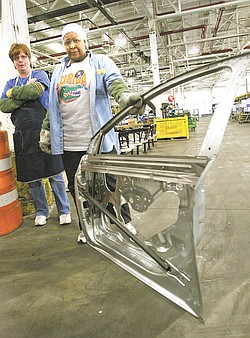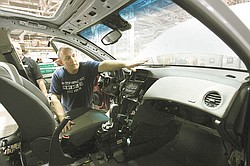Cruze control
By GRACE WYLER
gwyler@vindy.com
LORDSTOWN
Irene Torres of Austintown, left, and Bertha Brown of Warren, launch-team trainers for the Chevrolet Cruze, show off the side intrusion bar inside the door of the Cruze. The bar, made of high-strength steel, helps prevent the door from collapsing in the event of a crash.
Austintown, a launch team member, points out the 10 airbags inside the Cruze. The airbags are deployed by sensors that also alert OnStar and Automatic Crash Response in the event of a collision. The cooperation between management and workers is unprecedented at the Lordstown plant, Aeppli said.
The Chevrolet Cruze and its older sister, the Chevrolet Cobalt, are displayed on the fl oor of the General Motors complex in Lordstown. The last Cobalt will roll off the line June 24.
The Chevrolet Cruze won’t hit showrooms until this summer, but launch-team trainers at the General Motors plant here already are confident that the vehicle they are building will exceed safety and performance expectations.
And they would know.
Launch teams at the Lordstown complex have been working closely with engineers and manufacturers since November to perfect every stage of Cruze production.
The cooperation between the management and the workers on the Cruze is unprecedented at the Lordstown plant, said Jim Aeppli and Walt Valantine, members of a launch team working on some of the Cruze’s new crash-response features.
“It is the first launch that they have let the employees be involved to this extent,” Aeppli said. “We have had a lot of input, and they have been very receptive.”
The launch teams are helping the manufacturers find and solve problems in the Cruze before production begins.
“Before, they wanted to force quality on the assembly line, and you can’t do that — there’s no time,” Valantine said. “Now we are working together in-depth. It’s going to make a big difference.”
Involvement in the car’s development has given the launch team a detailed understanding of the car’s safety features that they can pass on to their fellow Lordstown workers, Aeppli said.
And the outlook of the workers’ has changed as they have become more involved in the development process, Valantine said.
“When you get more ownership, you take more pride,” he added.
The launch teams have completed the development process and are moving into the training stage. The teams will spend the next few months training other workers in Cruze production and setting up work stations.
“We figured out the best way to do the job, and we wrote it up and are starting the cross-training now,” said Bertha Brown, who is working on crash-protection elements in the car’s structure.
Brown, who also worked on the launch of the Chevrolet Malibu, said the launch process was similar but the components have changed.
The Cruze, which has more parts than the Chevrolet Cobalt, is designed for structural soundness and safety.
The car incorporates high-strength steel in box-style enforcements that protect the car in the event of a crash.
Underbody main rails extend from the front of the vehicle to the back and connect with a steel beam that runs behind the dashboard.
The structural reinforcements, combined with steel crash bars in the doors, are designed to keep the passenger cabin from collapsing inward if the car is hit from the side, said Rick Dowd, the United Auto Workers launch trainer.
The car also has 10 airbags, including a roof rail-mounted head-curtain side airbag that protects the side of the car.
“It’s amazing that in a standard package you can get all that safety,” Valantine said.
The Cruze’s long, collaborative development process should also help to ensure that the initial production runs smoothly and the first cars shouldn’t encounter major safety problems, Valantine said.
SEE ALSO: Officials get a look at 2011 Cruze.
 43
43



